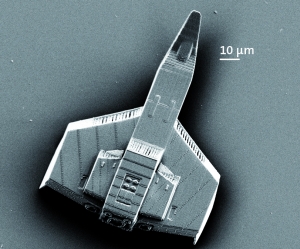Microscopic 3D printing
February 11, 2013

Printing or a miniaturized object like a spaceship model is reduced to less than one minute without loss of quality (credit: Nanoscribe)
Nanoscribe GmbH, a spin-off of Karlsruhe Institute of Technology (KIT), has developed the world’s fastest 3D printer of micro- and nanostructures, the German company claims.
With this printer, three-dimensional objects, often smaller than the diameter of a human hair, can be manufactured with minimum time consumption and maximum resolution. The printer is based on a novel laser lithography method.
Nanoscribe systems are used to print polymer waveguides reaching data transfer rates of more than 5 terabits per second.
Using the new laser lithography method, printing speed is increased by factor of about 100. This increase in speed results from the use of a special “galvo” mirror system, a technology that is also applied in laser show devices or scanning units of CD and DVD drives.
Reflecting a laser beam off the rotating galvo mirrors facilitates rapid and precise laser focus positioning. “We are revolutionizing 3D printing on the micrometer scale. Precision and speed are achieved by the industrially established galvo technology,” says Martin Hermatschweiler, the managing director of Nanoscribe GmbH.
The direct laser writing technique underlying the 3D printing method is based on two-photon polymerization. Just as paper ignites when exposed to sunlight focused through a magnifying glass, ultra-short laser pulses polymerize (fuse into large molecules) photosensitive materials in the laser focus. Depending on the photosensitive material chosen, only the exposed or unexposed volume is dissolved. After a developer bath, these written areas remain as self-supporting micro- and nanostructures.
This allow three-dimensional micro- and nanostructures to be printed rapidly and on large areas. At highest resolution, however, the scanning field is limited physically to a few 100 microns due to the optical properties of the focusing objective.